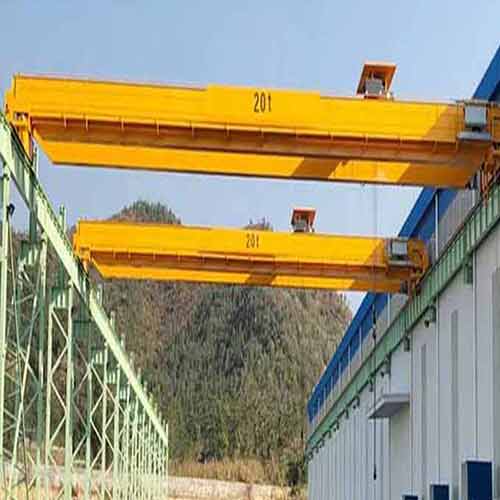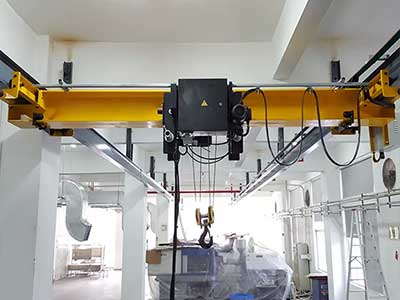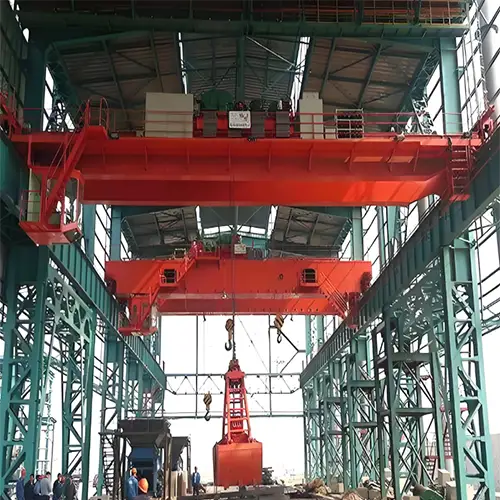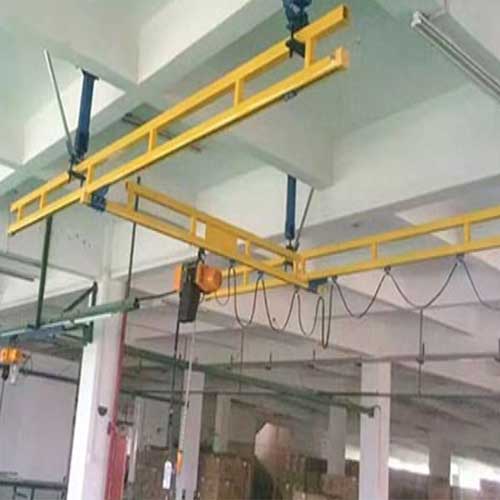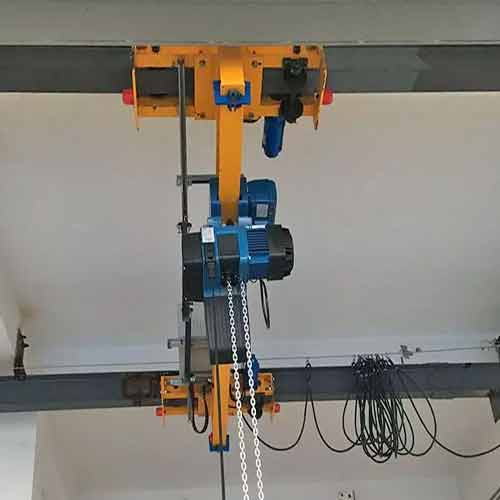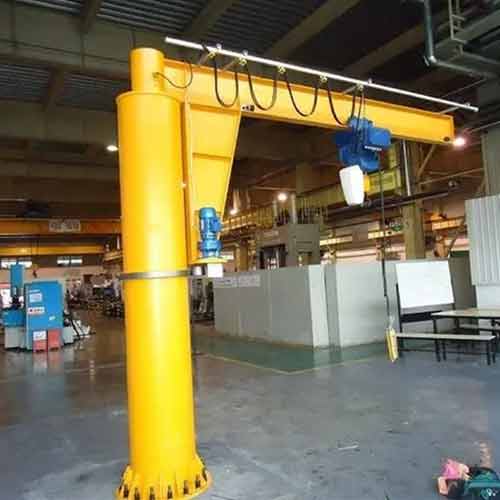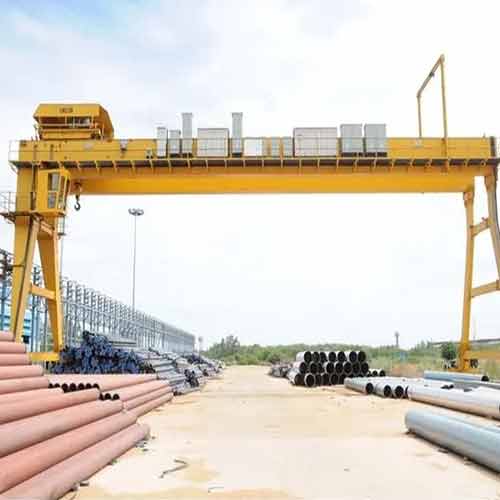Overhead Crane Systems: Overhead Bridge & Gantry Crane Systems
Overhead Crane System Guide, i.e. single & double girder top running& underhung overhead crane system, gantry system, jib system for indoor & outdoor use.
| Crane system | Custom crane system for various industrial sectors. |
| Bridge crane system | 0.5 ton - 100 ton |
| Gantry crane system | 1 ton - 320 ton |
| Jib crane system | 0.25 ton - 16 ton |
Category: Crane System
Your Trusted Overhead Crane Manufacturer & Supplier
Overhead Crane Systems: Overhead Bridge & Gantry Crane Systems
Custom Indoor Bridge Crane & Outdoor Gantry Crane System 5 Ton -80 Ton
Overhead Crane System Guide, i.e. single & double girder top running & underhung overhead crane system, gantry system, jib system for indoor & outdoor use.Ready on the Comprehensive Guide to Overhead Crane Systems: Types, Components, and Safety Features, etc.
Comprehensive Guide of Overhead Crane Systems on top running & underhung crane systems with single girder & double girder crane design, full and semi gantry systems with hoist gantry & open open gantry design, electric slewing jib crane system with floor and wall jib crane design, for indoor and outdoor use. Contact us to get your custom indoor crane systems including ceiling crane system, floor crane system, freestanding bridge crane system, and custom outdoor crane system such as freestanding rail mounted gantry & rubber typred gantry cranes system, etc.
In the vast landscapes of manufacturing and industrial domains, there exists a towering figure, often silently orchestrating the movements of colossal loads, ensuring precision, efficiency, and above all, safety. This unassuming yet formidable figure is none other than the overhead crane system, a mechanical marvel that has transformed the way we handle materials, enabling us to reach new heights of productivity and operational safety.
Overhead crane systems, also known as bridge cranes or gantry cranes, have become the backbone of diverse industries, from automotive manufacturing plants to busy warehouses and shipyards. These powerful machines, suspended high above the hustle and bustle of the workplace, have a single-minded mission: to lift, transport, and place heavy loads with unwavering precision.
In this comprehensive guide, we embark on a journey through the world of overhead crane systems. We'll delve into their types, explore their key components, uncover advanced safety features, and share real-world insights. By the end of this journey, you'll not only understand the intricate mechanics of these incredible machines but also appreciate their significance in optimizing material handling operations.
So, fasten your seatbelts and prepare to be transported into the realm of overhead crane systems, where every lift is a testament to engineering excellence, every movement a symphony of precision, and every safety feature a guardian of workplace well-being.
Your Trusted Overhead Crane Manufacturer & Supplier
Overhead Bridge Crane Systems
Our voyage begins with a close encounter with the workhorse of manufacturing and material handling facilities—the overhead bridge crane. These colossal systems, perched high on sturdy runways, consist of three main components: the bridge, trolley, and hoist. The bridge spans the width of the working area, the trolley moves along its length, and the hoist, equipped with various attachments, is responsible for lifting and lowering the loads.
Bridge crane systems, often referred to as overhead bridge cranes or simply overhead cranes, are industrial machines used for lifting and transporting heavy loads within a facility. They consist of a bridge, which runs along elevated runways, a trolley that moves horizontally along the bridge, and a hoist that is responsible for the vertical lifting and lowering of the load.
Key components of bridge crane systems:
- Bridge: The bridge is a horizontal beam that spans the width of the working area. It is typically supported by elevated runways, allowing the crane to move across the workspace. The bridge provides a stable platform for the trolley and hoist to operate.
- Trolley: The trolley is mounted on the bridge and moves horizontally along the length of the bridge. It carries the load, allowing it to be positioned precisely within the workspace. The trolley can be manually operated or motorized for efficient material handling.
- Hoist: The hoist is the lifting mechanism of the bridge crane. It is attached to the trolley and is responsible for lifting and lowering heavy loads. Hoists come in various types and configurations, including electric chain hoists, wire rope hoists, and more, depending on the specific lifting requirements.
Bridge crane systems are known for their versatility and efficiency in various industries, including manufacturing, warehousing, construction, and shipyards. They are essential for tasks such as moving machinery components, lifting and positioning materials, and optimizing storage space in warehouses.
These systems are not only efficient but also contribute to workplace safety by reducing the need for manual labor and ensuring precise material handling. Bridge crane systems can be customized to meet the specific needs of different industries, making them a vital tool for enhancing productivity and streamlining material handling processes.
Overhead Bridge Crane Runway System
Overhead bridge crane runway systems, also known as crane runways or crane tracks, are a critical component of overhead crane systems. These systems consist of a network of rails or beams installed overhead, which provide a stable and elevated pathway for the bridge of the overhead crane to move along.
Key points about overhead crane runway systems:
- Support Structure: The overhead crane runway system is typically mounted on the framework of the building or on specially designed supporting structures, such as columns or beams. The runway structure is securely anchored to the building to ensure stability and safety.
- Bridge Movement: The bridge of the overhead crane, which carries the trolley and hoist, travels along the runway system. This movement allows the crane to cover the entire working area and provides access to various locations within the facility.
- Types of Runways: There are two main types of overhead crane runway systems: top running and underhung.
- Top Running Runway: In a top running system, the bridge of the crane runs on rails or beams installed on the top of the supporting structure. This design allows for heavier load capacities and is commonly used in industrial settings.
- Underhung Runway: Underhung runways are installed beneath the supporting structure, making them suitable for facilities with limited headroom. While they typically have lower load capacities than top running runways, they are a practical choice for smaller workspaces.
- Runway Maintenance: Regular maintenance and inspection of the runway system are essential to ensure safe and efficient crane operation. This includes checking for any signs of wear, damage, or misalignment and addressing these issues promptly.
- Load Capacity: The design and construction of the runway system should align with the load capacity requirements of the overhead crane. The structural integrity of the runway system is critical to prevent accidents and maintain safety.
- Customization: Overhead crane runway systems can be customized to suit the specific needs of the facility. This may include considerations for the layout of the workspace, the types of materials to be lifted, and any height or space restrictions.
- 7. Safety Measures: Overhead crane runway systems are integral to maintaining a safe working environment. Proper installation, inspection, and adherence to safety standards are crucial to prevent accidents and ensure worker safety.
Overhead crane runway systems are an essential part of the infrastructure in facilities that rely on overhead cranes for material handling. They provide the structural framework that enables the bridge crane to operate efficiently, transporting heavy loads with precision and contributing to increased productivity in various industries.
Top Running Crane Systems vs. Underhung Crane Systems
While overhead bridge cranes dominate many industrial landscapes, there are alternatives suited to specific needs. Enter the top running crane systems and underhung crane systems, each with its unique characteristics.
- Making the Right Choice: Top running cranes are known for their robust construction and capacity to handle heavy loads. They run on top of runway beams and are excellent for applications that demand high load-bearing capacity. On the other hand, underhung crane systems are ideal for facilities with limited space as they run beneath runways. They provide efficient and precise material handling, especially in smaller working areas.
- Sizing Up: When selecting an overhead crane system, load capacity and sizing play a pivotal role. Consider a scenario where a steel foundry must regularly move massive metal ingots. In such cases, a top running crane system with the capacity to manage such hefty loads is essential. Conversely, a manufacturing workshop with limited floor space might opt for an underhung crane system to maximize the use of available room.
When it comes to overhead crane systems, two main players take the stage: top running crane systems and underhung crane systems. Each of these systems has its own unique characteristics and strengths, making them suitable for different scenarios.
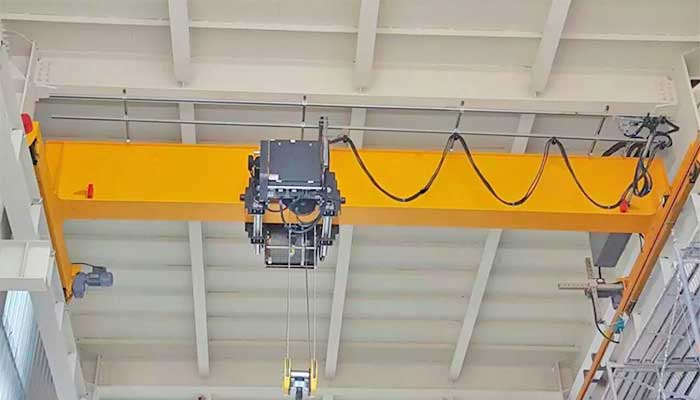
Characteristics:
- Top Position: In top running systems, the bridge runs on rails or beams installed on the top of the supporting structure.
- Heavier Loads: These systems are designed for heavier load capacities and are commonly used in industrial settings where robust lifting power is essential.
- Ample Headroom: They require more vertical clearance but offer the advantage of accommodating larger and heavier loads.
- Stability: Top running systems provide added stability, making them ideal for tasks involving substantial loads.
Load Capacity and Sizing Considerations:
- When selecting a top running crane system, it's essential to assess the weight of the loads you intend to lift. These systems are well-suited for applications with substantial weight requirements, such as manufacturing facilities dealing with heavy machinery components.
- Top Running Runway Systems: These runways are designed to accommodate the top running crane systems, providing the necessary structure for them to travel along the top of the supporting framework. They are engineered to handle the heavier loads associated with top running cranes.
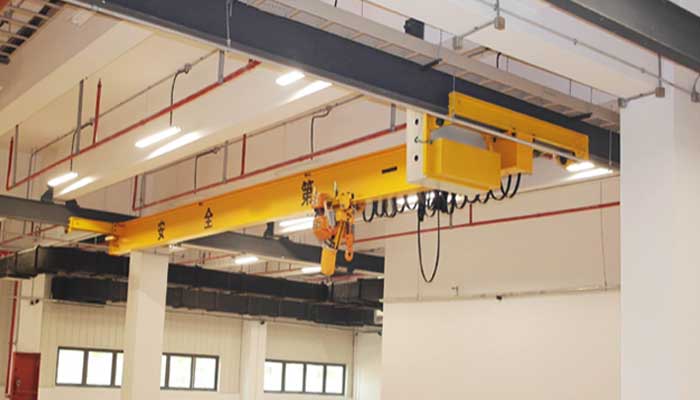
Characteristics:
- Beneath the Structure: Underhung crane systems are installed beneath the supporting structure, which is particularly useful for facilities with limited headroom.
- Space Efficiency: They offer a more space-efficient design, making them suitable for smaller workspaces or buildings with low clearance.
- Lighter Loads: While underhung systems have lower load capacities compared to their top running counterparts, they excel in scenarios where space is a premium.
Load Capacity and Sizing Considerations:
- Underhung crane systems are a practical choice when dealing with lighter loads, and space constraints are a consideration. They are often used in smaller industrial environments where optimizing available space is crucial.
- Underhung Runway Systems: These runways are installed beneath the supporting structure, aligning with the underhung crane systems. They are tailored to the spatial constraints of the underhung system and are optimized for smaller workspaces.
In both cases, proper sizing and load capacity considerations are critical to ensure the safe and efficient operation of the overhead crane system. The selection between top running and underhung systems, as well as the corresponding runway systems, ultimately depends on the specific needs of your facility, the nature of the loads you handle, and the available workspace. By understanding the distinctions between these systems, you can make a well-informed choice that optimizes both productivity and safety in your material handling operations. Check more on top running and underhung bridge crane systems or leave me a message downblow to get your custom design!
Lightweight Overhead Crane Systems: Versatility and Efficiency
Lightweight overhead crane systems are the agile performers of the material handling world, designed to navigate the challenges of weight restrictions and adapt to dynamic environments. These systems bring their own set of unique advantages to the table, making them indispensable in various industrial settings.
Lightweight Overhead Crane Systems
As industries diversify and innovate, so too do the demands placed on overhead crane systems. Lightweight overhead crane systems have emerged as a solution to meet the unique requirements of facilities where weight restrictions are a primary concern.
- Weight Matters: Lightweight overhead cranes are tailor-made for facilities where the structural load capacity of the building is limited. These systems are designed to handle materials while exerting minimal additional weight on the structure, thus preserving the integrity of the building.
- Environmental Considerations: Beyond the weight restrictions, lightweight overhead crane systems also excel in environments where temperature extremes, humidity, or corrosive conditions are prevalent. They are equipped to withstand the harshest of operational settings.
Main types of lightweight overhead crane systems
Lightweight overhead crane systems are a specialized category of overhead cranes designed for applications where weight restrictions are a primary concern. These cranes are engineered to be lightweight and efficient while maintaining their structural integrity. They are particularly well-suited for facilities with limited load-bearing capacities or those requiring precise material handling.
The main types of lightweight overhead crane systems include:
- Monorail Cranes: Monorail cranes consist of a single rail or track, which can be installed in a fixed path. They are suitable for linear material transport in environments with weight restrictions.
- Telescoping bridge cranes: Telescoping bridge cranes are a variation of bridge cranes designed to have telescoping sections. This feature allows for variable bridge lengths and reach.
- Workstation Bridge Cranes: Workstation bridge cranes are installed above workstations or assembly areas, providing a lightweight and efficient solution for moving materials or components within a specific workspace.
- KBK rail Cranes :KBK rail cranes are modular systems featuring lightweight components, including aluminum rails, suspensions, trolleys, and hoists. These can be easily configured to meet specific material handling needs.
- Aluminum Bridge Cranes: These cranes are constructed with aluminum components, which are lightweight and corrosion-resistant. They are ideal for settings with weight restrictions and environments where corrosion is a concern, such as food processing facilities or laboratories.
Main types of lightweight overhead crane systems, including Monorail Cranes, Telescoping Bridge Cranes, Workstation Bridge Cranes, KBK Rail Cranes, and Aluminum Bridge Cranes:
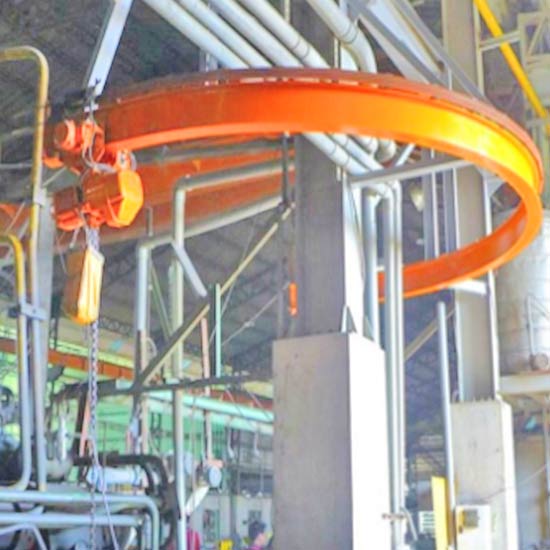
Overview: Monorail cranes consist of a single rail or track, which can be installed in a fixed path. They are suitable for linear material transport in environments with weight restrictions.
Typical Monorail Crane Design, Configurations & Capacity: Monorail cranes are designed with a single rail or track, along which a trolley moves. They come in various configurations, including ceiling-mounted and freestanding. Capacity varies but is often suited for lighter loads.
Features and Benefits: Monorail cranes are known for their space efficiency, making them ideal for environments with limited headroom. They offer precise material handling and are easily adaptable to various spaces.
Typical Industrial Applications & Workshops: Monorail cranes are commonly used in manufacturing plants, assembly lines, and workshops where linear transport of materials or components is required, such as in automotive assembly or machining operations.
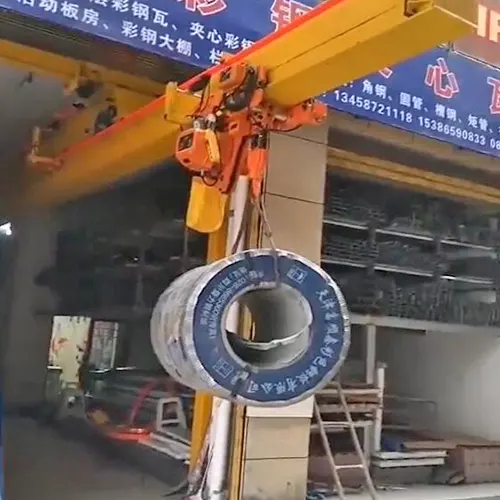
Overview: Telescoping bridge cranes are a variation of bridge cranes designed to have telescoping sections. This feature allows for variable bridge lengths and reach.
Typical Telescoping Bridge Crane Design, Configurations & Capacity: These cranes have a bridge with telescoping sections, often with a single or double girder design. Their capacity can vary depending on the specific configuration and requirements.
Features and Benefits: Telescoping bridge cranes provide enhanced reach and flexibility, allowing them to adapt to different material handling scenarios. They are often used for tasks that require extended reach and precision.
Typical Industrial Applications & Workshops: Telescoping bridge cranes find application in facilities with varying load sizes or where materials need to be reached in difficult-to-access areas, such as in warehouses, loading docks, or construction sites.
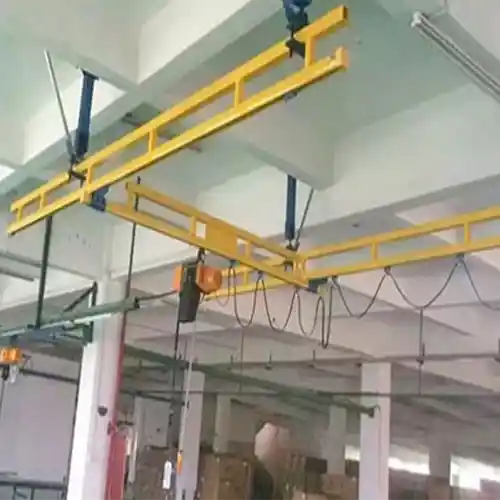
Overview: Workstation bridge cranes are installed above workstations or assembly areas, providing a lightweight and efficient solution for moving materials or components within a specific workspace.
Typical Workstation Bridge Crane Design, Configurations & Capacity: These cranes typically consist of a bridge and trolley system designed for load capacities suitable for workstation needs. Configurations are tailored to individual workstations.
Features and Benefits: Workstation bridge cranes improve material handling efficiency within a specific workspace. They are easy to install and require minimal space. Their adaptability supports streamlined processes.
Typical Industrial Applications & Workshops: Workstation bridge cranes are commonly used in assembly lines, workshops, and smaller industrial settings where materials need to be moved efficiently within a confined workspace, such as in small-scale manufacturing or product assembly operations.
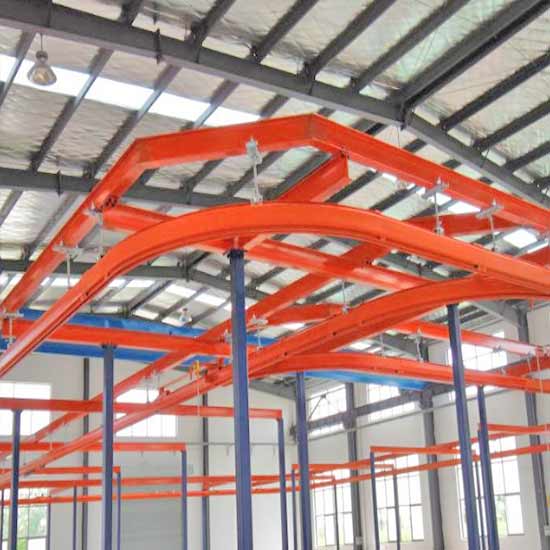
Overview: KBK rail cranes are modular systems featuring lightweight components, including aluminum rails, suspensions, trolleys, and hoists. These can be easily configured to meet specific material handling needs.
Typical KBK Rail Crane Design, Configurations & Capacity: The modular nature of KBK rail cranes allows for flexible design and capacity configurations. They are often characterized by their adaptability and efficient layout.
Features and Benefits: KBK rail cranes offer versatility, adaptability, and cost-efficiency. They are well-suited for environments with weight restrictions, limited headroom, or those requiring precise material handling.
Typical Industrial Applications & Workshops: KBK rail cranes find use in various industrial settings, including manufacturing plants, warehouses, assembly lines, and facilities that require agile and efficient material handling solutions.
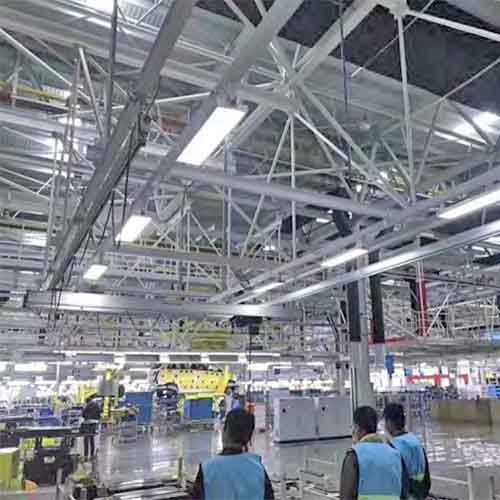
Overview: Aluminum bridge cranes are designed with lightweight aluminum components, making them ideal for environments where weight restrictions or corrosion resistance are essential.
Typical Aluminum Bridge Crane Design, Configurations & Capacity: These cranes feature aluminum construction, which offers a balance of strength and weight savings. Their configurations vary based on capacity and application.
Features and Benefits: Aluminum bridge cranes are corrosion-resistant and well-suited for environments with humidity, temperature extremes, or corrosive conditions. They are adaptable and durable.
Typical Industrial Applications & Workshops: Aluminum bridge cranes are commonly used in industries such as food processing, laboratories, and other settings where corrosion resistance and lightweight material handling are crucial.
The choice of the lightweight overhead crane system depends on the specific requirements of the facility, including load capacity, available space, and environmental conditions. Lightweight cranes are known for their adaptability, cost-efficiency, and ability to operate in environments with weight restrictions. They are essential tools for industries such as manufacturing, assembly, maintenance, and more, where precise and efficient material handling is crucial.
Applications of Lightweight Overhead Crane System :
Lightweight overhead crane systems are the ideal choice for facilities where weight restrictions are a primary concern. Here are some practical applications where these systems shine:
- Precise Material Handling: In settings such as precision manufacturing or delicate assembly work, lightweight cranes offer the finesse required to move materials with utmost precision.
- Limited Building Capacity: For older structures or buildings with weight restrictions, lightweight crane systems allow for efficient material handling without overloading the structure.
- Environmental Control: In environments where temperature extremes, humidity, or corrosive conditions are prevalent, lightweight cranes are more adaptable and durable compared to their heavier counterparts.
The Advantages:
Lightweight overhead crane systems come with a host of advantages, including:
- Reduced Structural Load: These cranes exert less additional weight on the building structure, preserving the integrity of the facility and extending its longevity.
- Lower Operating Costs: Lightweight cranes often require smaller support structures and consume less energy during operation, resulting in cost savings over time.
- Increased Flexibility: Their adaptability to various environments and ability to work in tight spaces make lightweight cranes versatile and practical for a wide range of tasks.
Managing Environmental Factors:
When utilizing lightweight crane systems, it's essential to consider environmental factors to ensure optimal performance:
- Temperature Control: In extreme temperature conditions, ensure that the crane's components are designed to withstand variations in heat and cold. Consider insulation and protective measures for electrical components.
- Corrosion Resistance: If the environment is corrosive, select materials that resist corrosion, such as stainless steel. Regular maintenance, including cleaning and applying protective coatings, can also extend the crane's lifespan.
- Humidity and Moisture Control: Proper ventilation and dehumidification in the crane area can help reduce the impact of humidity on the crane's electrical and mechanical components.
- Safety Measures: Lightweight cranes, like their heavier counterparts, require safety features such as limit switches, emergency stop buttons, and safety inspections to ensure worker safety and prevent accidents.
In summary, lightweight overhead crane systems are a practical solution for facilities with weight restrictions and challenging environmental conditions. Their adaptability, cost-efficiency, and ability to navigate delicate material handling tasks make them valuable assets in various industries. By considering the specific needs and environmental factors of your facility, you can harness the full potential of lightweight crane systems while ensuring the safety and efficiency of your material handling operations.
Indoor and Outdoor Crane Systems: Making the Right Choice
The industrial world is not confined to a single environment, and overhead crane systems adapt accordingly. They seamlessly transition from the controlled indoors to the rugged outdoors, offering distinct advantages in each setting.
- Indoor Precision: Indoor overhead crane systems play a vital role in manufacturing and storage facilities, ensuring precise material handling with the safety of a controlled environment. However, they require their own set of maintenance considerations to keep operations running smoothly.
- Venturing Outdoors: Outdoor overhead bridge crane systems are designed to thrive in the elements. They are equipped to handle environmental challenges, such as exposure to the elements, temperature variations
Indoor and outdoor crane systems serve distinct purposes, and understanding their roles, maintenance requirements, and safety considerations is essential for making informed decisions in material handling operations.

Indoor Overhead Crane Systems:
Pivotal Role in Manufacturing and Storage:
- Indoor overhead crane systems play a pivotal role in manufacturing and storage facilities, enabling efficient material handling, production processes, and inventory management.
- They are commonly used for lifting heavy machinery components, transporting raw materials, and optimizing storage space in warehouses.
- Maintenance is crucial to ensure smooth, safe operation. Regular inspections, lubrication, and component checks are essential to prevent downtime and ensure worker safety.
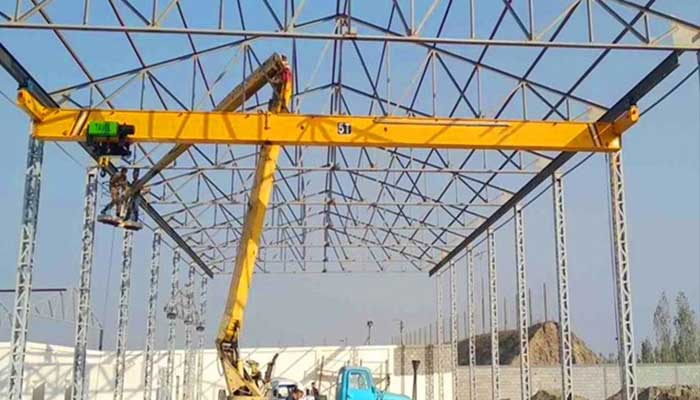
Outdoor Overhead Bridge Crane Systems:
Importance of Outdoor Cranes:
- Outdoor overhead bridge crane systems are indispensable for outdoor applications, including shipyards, construction sites, and open-air storage yards.
- They are built to withstand the elements, harsh weather conditions, and exposure to outdoor environments.
- Outdoor crane maintenance is critical to protect against corrosion, ensure proper operation, and extend the crane's lifespan.
Outdoor Maintenance and Safety Guidelines:
- Outdoor cranes require additional maintenance to combat exposure to the elements. This includes regular inspection of structural components for signs of corrosion, protective coatings, and ensuring electrical systems are weather-resistant.
- Safety measures for outdoor cranes include monitoring wind conditions and having protocols in place for crane shutdown during adverse weather. Operator training is essential to handle outdoor challenges effectively.
Comparison of Indoor and Outdoor Crane Systems:
Environmental Considerations:
- Indoor cranes are sheltered from weather conditions and environmental elements, offering a controlled workspace.
- Outdoor cranes must contend with rain, wind, extreme temperatures, and potential corrosion due to exposure to the elements.
Load Handling:
- Indoor cranes often handle a wide range of materials within a specific facility, optimizing indoor storage and material flow.
- Outdoor cranes are frequently used for heavy outdoor materials, such as construction materials, large equipment, and shipping containers.
Maintenance Requirements:
- Indoor cranes require regular maintenance focused on the mechanical components, electrical systems, and ensuring that safety features are operational.
- Outdoor cranes require additional attention to the protection of structural elements, corrosion prevention, and adverse weather protocols.
Operational Flexibility:
- Indoor cranes are tailored to the specific needs of a single facility and are not exposed to variable external conditions.
- Outdoor cranes must adapt to diverse environments, making their design more rugged and resistant to weather extremes.
In summary, the choice between indoor and outdoor overhead bridge crane systems depends on the specific operational needs of a facility. Indoor cranes excel in controlled environments with a focus on efficient material handling and storage optimization. In contrast, outdoor cranes are built to withstand the elements, making them suitable for outdoor applications that require robust lifting power and resilience against adverse weather conditions. By understanding the distinctions between these systems, businesses can make informed decisions to enhance productivity while ensuring worker safety.
Your Trusted Overhead Crane Manufacturer & Supplier
Overhead Gantry Crane Systems
Overhead gantry crane systems are versatile workhorses in the world of material handling, designed for robust lifting and positioning of heavy loads. These systems offer an array of types, each tailored to specific applications and load-bearing capacities.
Overhead gantry crane systems feature a horizontal bridge, similar to traditional overhead cranes, but with upright legs on either side. This design provides stability and versatility for various lifting tasks.- The bridge can be single or double girder, depending on the required load capacity, with trolleys and hoists for vertical movement.
Gantry cranes find application in a wide range of industries, including manufacturing, construction, shipyards, and more. They are ideal for tasks such as loading and unloading shipping containers, assembling heavy machinery, and moving large, unwieldy materials.
Their flexibility allows them to handle a variety of loads, making them essential in facilities where materials range from small components to massive machinery.
Single Girder vs. Double Girder Gantry Crane System
Single girder and double girder gantry crane systems are two common configurations of overhead gantry cranes, which can be used for indoor and outdoor use, each with its own unique characteristics and advantages. Let's explore them:
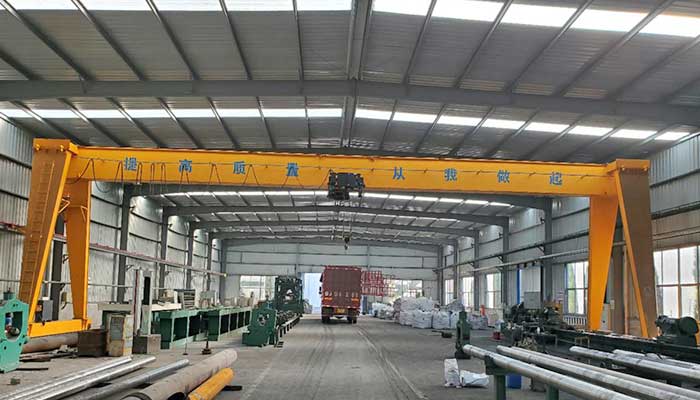
Single Girder Gantry Crane Systems:
Design and Features:
- Single girder design: Single girder gantry cranes have one horizontal beam (girder) spanning the width of the crane. This design is known for its simplicity and efficiency.
- Light to moderate load capacity: These cranes are suitable for handling lighter to moderate loads, making them cost-effective and versatile.
- Compact design: Single girder gantry cranes have a more compact design, making them ideal for facilities with space constraints.
Advantages:
- Cost-effective: Single girder gantry cranes are typically more affordable than their double girder counterparts, making them a budget-friendly choice for many applications.
- Efficiency: They are well-suited for tasks that require precise material handling and agility, such as manufacturing, workshops, and warehouses.
- Space-saving: Their compact design optimizes space utilization within a facility, allowing for efficient material flow and storage.
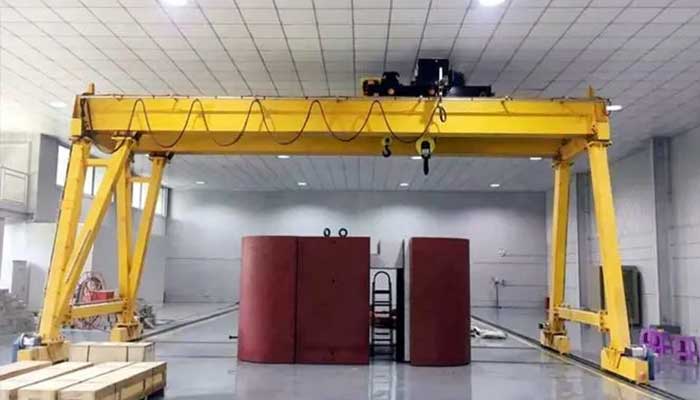
Double Girder Gantry Crane Systems:
Design and Features:
- Double girder design: Double girder gantry cranes have two horizontal girders supporting the trolley and hoist. This design offers increased strength and load-bearing capacity.
- Heavy load capacity: These cranes are capable of handling heavy and oversized loads, making them suitable for demanding applications.
- Taller lift heights: The double girder design provides greater lift heights, allowing for efficient vertical movement of materials.
Advantages:
- High load capacity: Double girder gantry cranes are ideal for applications that involve lifting heavy machinery components, large equipment, or materials with substantial weight.
- Durability: Their robust design and load-bearing capacity make them durable and reliable in heavy-duty industrial environments.
- Versatility: Double girder gantry cranes are adaptable to a wide range of tasks, making them suitable for various industries, including manufacturing, construction, and shipyards.
Choosing Between Single and Double Girder Gantry Cranes:
The choice between single and double girder gantry crane systems depends on specific operational needs:
- Single Girder Cranes: These are cost-effective, space-saving options for facilities with lighter to moderate lifting requirements.
- Double Girder Cranes: These are the go-to choice when dealing with heavy loads, taller lift heights, and demanding applications.
Overhead gantry crane systems offer an exceptional combination of strength and adaptability, making them invaluable tools in various industries. The choice of gantry crane type depends on load-bearing requirements and specific applications. Whether it's moving ship components in a shipyard, stacking shipping containers in a port, or handling materials in a workshop, gantry cranes are pivotal in streamlining material handling processes and improving overall productivity. Click to learn more on indoor gantry system and outdoor gantry system or leave us a message to get your custom gantry crane system.
Rail Mounted & Rubber Tyred Travelling Gantry Crane Systems
The gantry crane rail system and rubber crane traveling system are integral components of gantry crane technology. Let's explore these systems in detail:
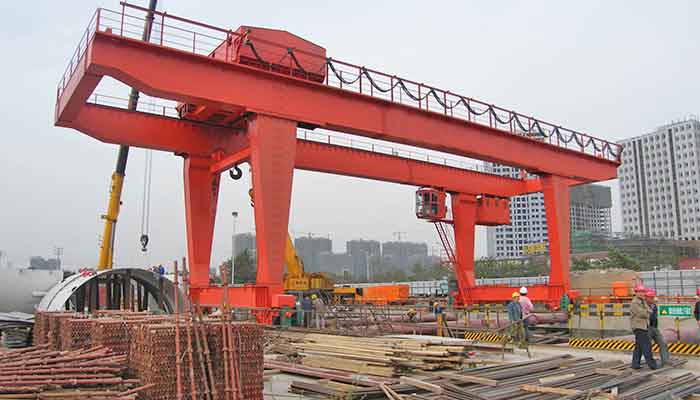
Overview:
- The gantry crane rail system consists of the tracks or rails on which the crane travels. These rails are essential for the crane's movement and positioning within a facility.
- Gantry cranes may run on different rail systems, including single or double rails, depending on the design and load-bearing requirements of the crane.
Design and Features:
- Single Rail System: This system consists of a single rail track on which the crane moves. It is typically used in applications where there's a need for lateral movement.
- Double Rail System: A double rail system features two parallel tracks for the crane's wheels, providing additional stability and load-bearing capacity.
Advantages:
- Gantry crane rail systems ensure smooth and precise movement of the crane, making them essential for applications that require precise positioning of heavy loads.
- They offer a reliable and durable foundation for gantry cranes, enhancing the safety and efficiency of material handling operations.
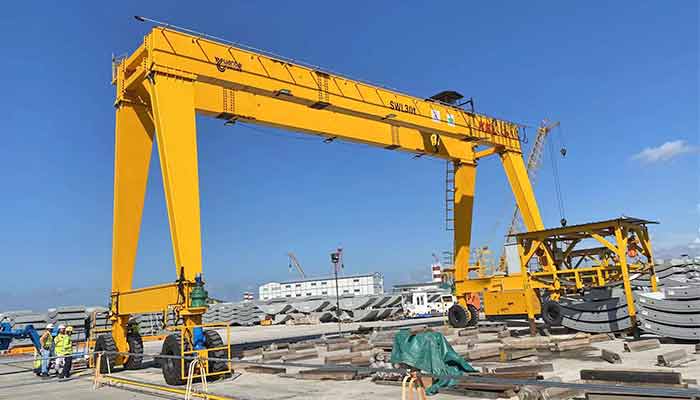
Rubber Crane Traveling Systems:
Overview:
- Rubber crane traveling systems are designed to provide mobility and versatility to gantry cranes. These systems use rubber tires or wheels for movement rather than traditional steel tracks.
- They are commonly found in rubber-tired gantry cranes (RTGs) used in container terminals, shipyards, and other industrial settings.
Design and Features:
- Rubber Tires/Wheels: Rubber tires or wheels are mounted on the crane's legs, allowing for efficient and flexible movement. The rubber material provides traction and stability.
- Mobility: Rubber crane traveling systems enable gantry cranes to move around the workspace with ease, offering greater versatility in material handling tasks.
Advantages:
- The use of rubber tires or wheels provides mobility and adaptability for gantry cranes. This is particularly advantageous in settings where the crane needs to traverse different surfaces or where rail systems are impractical.
- Rubber crane traveling systems are well-suited for environments that require fast and efficient movement of containers or heavy loads, such as container yards or ports.
Choosing Between Rail and Rubber Systems:
The choice between a gantry crane rail system and a rubber crane traveling system depends on specific operational needs:
- Gantry Crane Rail System: These systems are ideal for facilities with a fixed path for crane movement and applications that demand precise positioning. They are commonly used in manufacturing plants and warehouses.
- Rubber Crane Traveling System: Rubber systems are best for scenarios where the crane needs mobility and versatility to move around different surfaces or when there's a need for high-speed operation. They are frequently found in container handling operations, such as container terminals and shipyards.
Rubber-Tired Gantry Cranes (RTGs):
Load-Bearing Capacity: RTGs are heavy lifters, capable of handling substantial loads. They are commonly used in shipyards for moving ship components.
Mobility: Equipped with wheels, RTGs are mobile, offering the advantage of moving to different areas of the yard.
Rail-Mounted Gantry Cranes (RMGs):
Load-Bearing Capacity: RMGs are designed for lifting shipping containers and have substantial load-bearing capacities.
Fixed Rails: They are fixed on rails, making them efficient for repetitive tasks, such as container handling at intermodal facilities.
Both systems play critical roles in the efficiency and safety of material handling operations, and the choice depends on the specific requirements of a facility or project.
Portable Gantry Crane and Hoist Gantry Systems: On-Demand Lifting Solutions
Portable gantry crane and hoist gantry systems are the nimble juggernauts of the material handling world. These systems are designed to be easily moved to different locations, making them the go-to choice for temporary or versatile lifting requirements.

Portable Gantry Crane Systems:
Adaptability in Action:
- Portable gantry crane systems are a versatile solution for lifting tasks that are constantly on the move. These cranes are designed to be easily transported and set up in different locations.
- They shine in scenarios where temporary lifting needs arise, such as in construction sites, maintenance projects, or workshops with evolving workspaces.
Key Features and Benefits:
- Mobility: Portable gantry cranes are equipped with wheels, making them effortlessly mobile. Their assembly and disassembly are quick and straightforward.
- Versatility: These cranes are adaptable and can be used for a wide range of tasks, from hoisting equipment in a construction site to assisting with vehicle maintenance in a workshop.
- Cost-Effective: They offer cost-efficiency and can be more budget-friendly than permanent crane installations.

Single Girder Hoist Gantry Systems- Hoist Crane System:
On-Demand Lifting Power:
- Hoist gantry systems take the portable concept a step further. They combine the convenience of mobility with the lifting precision of hoists, ensuring that temporary or versatile lifting requirements are met with ease.
- These systems are ideal for locations where hoisting, lowering, and precise positioning are essential, such as assembly lines, workshops, and machinery maintenance areas.
Benefits:
- Efficiency: Hoist gantry systems provide efficient solutions for moving heavy components or equipment within a workspace. They are designed for agility and speed.
- Space Optimization: In settings with limited space, hoist gantry systems offer an advantage by allowing materials to be lifted and positioned with precision, making the most of the available area.
- Safety: Their operation is user-friendly, with built-in safety features and controls that ensure secure lifting and lowering of loads.
Portable gantry crane and hoist gantry systems are your on-demand lifting companions. They offer adaptability, mobility, and precision for temporary or versatile lifting requirements in various settings. Whether you need to move materials in a construction site, position heavy components on an assembly line, or perform maintenance tasks in a workshop, these systems are essential tools that ensure efficient and safe material handling.
Your Trusted Overhead Crane Manufacturer & Supplier
Overhead Jib Crane Systems
Overhead jib crane systems are essential tools in material handling, known for their efficient and precise lifting capabilities. These systems come in various designs, with some mounted on walls or floors, and some featuring a rotary traveling system. Let's delve into the intricacies of overhead jib crane systems and explore the key differences between these variations.
- Design Essentials:- Overhead jib crane systems consist of a horizontal boom (jib) that supports a trolley and hoist. The jib is connected to a support structure, either mounted on the wall or the floor.
- They are designed for efficient lateral movement, allowing for precise positioning of loads within a defined workspace.
- Applications:- Overhead jib cranes find applications in various industries, including manufacturing, automotive, and construction. They are ideal for tasks such as loading and unloading materials, assembly line work, and machine maintenance.
The choice of jib crane design depends on specific material handling requirements.
Comparison Between Floor and Wall-Mounted Jib Crane Systems:

Floor-Mounted Jib Crane Systems:
Advantages: Floor-mounted jib cranes offer stability and load-bearing capacity. They are often used for heavy lifting tasks and in areas where wall space is limited.
Operational Advantages: These cranes have a fixed base, ensuring robust support. They are capable of 360-degree rotation, providing versatility in load positioning and precise material handling.
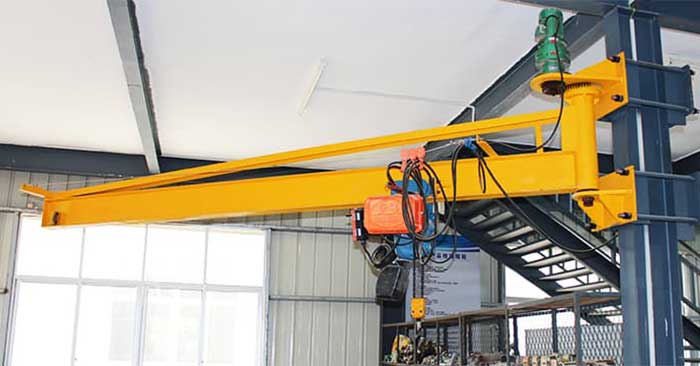
Wall-Mounted Jib Crane Systems:
Advantages: Wall-mounted jib cranes are space-efficient, as they are attached to existing structures. They are suitable for light to moderate loads and areas where floor space is valuable.
Operational Advantages: These cranes provide a clear floor space, allowing for unobstructed movement and efficient use of workspace. They offer 180-degree rotation, focusing on specific areas within the workspace.
Rotary Traveling System of Overhead Jib Cranes:
Some overhead jib crane systems feature a rotary traveling system, which allows for linear and circular movement. This system adds an extra dimension of mobility and flexibility to the crane.- Overhead jib cranes with a rotary traveling system excel in applications where materials need to be moved and positioned precisely, not just laterally but also in a circular path.- These systems are frequently used in settings like machine shops, where materials may need to be rotated for assembly or maintenance.
Types of rotary system of jib canes
Rotary systems in jib cranes allow for circular movement, which can be crucial in certain material handling applications. There are different types of rotary systems used in jib cranes:
- Manual Rotation: This is the simplest and most basic form of rotary system. In manual rotation, the operator physically moves the jib crane to the desired position. This can be done by hand or using a manual crank or lever. Manual rotation is typically found in smaller, lighter-duty jib cranes and is well-suited for applications where infrequent or occasional rotation is required.
- Motorized Rotation: Motorized rotation is a more advanced and automated system. It involves the use of an electric motor to control the rotation of the jib crane. This system allows for precise and controlled rotation, making it ideal for applications where frequent and accurate positioning is essential. Motorized rotation is often used in medium to heavy-duty jib cranes.
- Continuous Rotation: Some jib cranes are designed for continuous rotation, allowing them to rotate 360 degrees without any limitations. These cranes are commonly used in applications where materials need to be accessed from any direction, such as loading and unloading materials in open areas or large workspaces. Continuous rotation is typically found in heavier-duty jib cranes with motorized rotation systems.
- Limited Rotation: Limited rotation systems restrict the jib crane's movement to a specific range or angle, often less than 360 degrees. This type of system is suitable for applications where materials are typically accessed within a defined area. Limited rotation can be set according to the specific requirements of the workspace.
The choice of rotary system depends on the material handling needs of the application. For example, manual rotation may be suitable for occasional positioning, while motorized or continuous rotation is more appropriate for applications that demand precise and frequent repositioning of loads. The specific type of rotary system used in a jib crane will be determined by factors such as load capacity, workspace layout, and operational requirements.
Overhead jib crane systems, with their floor-mounted or wall-mounted designs and optional rotary traveling systems, provide efficient material handling solutions. The choice of design depends on load-bearing requirements, space availability, and the specific tasks the crane will perform. These versatile systems contribute to improved productivity and safety in a wide range of industrial applications.
Your Trusted Overhead Crane Manufacturer & Supplier
Overhead Crane System Key Components and Subsystems
Trolley System for Overhead Cranes: Precision in Horizontal Movement
The trolley system is a pivotal component of overhead cranes, facilitating the horizontal movement of heavy loads with precision and efficiency. In this section, we'll explore the critical role of the trolley system, customization options, the advantages it offers, and the importance of consistent maintenance.
Critical Role in Horizontal Movement:
The trolley system is responsible for moving the load horizontally along the length of the bridge or gantry crane. It consists of wheels or rollers that travel along the crane's runway, allowing for the smooth and controlled movement of the load. The trolley is attached to the hoist, which handles vertical lifting, creating a seamless material handling process.
Customization Options:
- Single Girder and Double Girder Trolleys: Trolleys come in both single girder and double girder configurations, allowing for versatility in load capacity. Single girder trolleys are used with single girder cranes, while double girder trolleys are employed in double girder crane systems.
- Motorized and Manual Trolleys: Trolley systems can be motorized or manual. Motorized trolleys offer automation and precise control, while manual trolleys are operated by the crane operator's physical effort.
- Variable Speed Control: Some trolley systems feature variable speed control, enabling operators to adjust the horizontal movement speed based on load requirements.
Advantages:
- Precision and Control: The trolley system provides precise control over the horizontal movement of loads, allowing for accurate positioning and placement of materials.
- Efficiency: It enhances material handling efficiency by reducing the time and effort required to transport loads within a workspace.
- Versatility: Trolley systems are versatile and adaptable to various material handling tasks, making them a valuable component in diverse industries.
Importance of Maintenance:
Consistent maintenance is crucial for ensuring the longevity and safety of the trolley system. Regular inspections, lubrication of wheels and components, and the replacement of worn parts are essential to prevent downtime and maintain safe crane operation. Any issues with the trolley system should be promptly addressed to avoid potential accidents and disruptions in material handling operations.
In conclusion, the trolley system is a key player in the horizontal movement of heavy loads in overhead crane systems. Its customization options, advantages, and maintenance requirements make it an indispensable component for efficient and safe material handling. Whether in manufacturing, construction, or warehousing, a well-maintained trolley system contributes to increased productivity and operational precision.
Hoist System in Overhead Cranes: Elevating Material Handling Efficiency
The hoist system plays a vital role in overhead crane systems, enabling precise vertical lifting and positioning of heavy loads. In this section, we will explore the significance of hoists, delve into various hoist types, highlight their unique applications, and emphasize the importance of operator training.
Significance of Hoists:
The hoist system is the heart of an overhead crane, responsible for lifting and lowering heavy loads with precision and control. It consists of a motorized mechanism with a drum or lift wheel, around which the hoist rope or chain is wound. When activated, the hoist raises the load vertically, allowing for efficient material handling within a workspace.
Various Hoist Types:
Wire Rope Hoists:
- Applications: Wire rope hoists are well-suited for heavy-duty lifting tasks, such as moving large machinery components or materials in industrial settings.
- Advantages: They offer high lifting capacities and durability, making them suitable for demanding applications.
Chain Hoists:
- Applications: Chain hoists are versatile and commonly used in manufacturing, construction, and maintenance tasks. They are ideal for lifting loads in confined spaces.
- Advantages: They are compact, easy to operate, and provide reliable vertical lifting.
Electric Hoists:
- Applications: Electric hoists are used in a wide range of industries and applications, from warehouses to assembly lines. They offer efficient and controlled lifting.
- Advantages: They are powered by electricity, providing consistent and reliable performance with the ability to lift heavy loads.
Air Hoists:
- Applications: Air hoists are often used in environments where electrical power sources are limited or where explosion-proof equipment is required.
- Advantages: They are known for their lightweight design, making them suitable for portable and versatile lifting.
Operator Training:
Operator training is of paramount importance when working with hoist systems. Proper training ensures safe and efficient crane operation. Operators must be familiar with the specific hoist type they are using, understand load capacities, and know how to operate the crane controls accurately. Training also includes knowledge of safety procedures and protocols to prevent accidents and protect personnel and materials.
In conclusion, the hoist system in overhead crane technology is an essential component that facilitates vertical lifting and precise material positioning. The choice of hoist type depends on the specific application and load requirements. Operator training is critical to ensure safe and efficient crane operation, emphasizing the importance of both equipment and personnel in the material handling process.
Overhead Crane Remote Control Systems: Elevating Efficiency and Safety
Overhead crane remote control systems have revolutionized material handling by enhancing operational efficiency and operator safety. In this section, we'll shine a spotlight on the transformative impact of remote control systems and explore the latest technological advancements that are propelling crane systems into the future.
Enhancing Operational Efficiency:
Overhead crane remote control systems provide operators with the freedom to control the crane from a safe and advantageous vantage point. This translates to several key benefits:
- Improved Visibility: Operators have an unobstructed view of the load and its surroundings, enabling precise positioning and preventing accidents.
- Enhanced Productivity: Remote control systems allow for quicker response times, making material handling tasks more efficient.
- Reduced Downtime: Operators can quickly address issues or adjust load positioning without the need for physical adjustments, minimizing downtime.
Operator Safety:
The safety of crane operators is paramount, and remote control systems contribute significantly to this aspect:
- Reduced Exposure to Hazards: Operators can control the crane from a safe distance, minimizing the risk of injury from falling objects or other workplace hazards.
- Safer Handling of Precious or Hazardous Materials: Remote control systems are particularly valuable when handling delicate or dangerous materials, as they allow for precise and cautious maneuvers.
- Emergency Stop Functionality: Many remote control systems come equipped with emergency stop buttons, providing immediate safety in case of unforeseen situations.
Technological Advancements:
The latest technological advancements in remote control systems are driving crane systems into the future:
- Automation: Automation features are increasingly integrated into remote control systems, enabling automated crane movements for repetitive tasks. This not only improves efficiency but also reduces operator fatigue.
- Smart Monitoring: Remote control systems are becoming smarter, with the ability to monitor crane performance, detect issues, and provide real-time feedback to operators and maintenance teams.
- Integration with IoT and Data Analytics: Remote control systems are now part of the Internet of Things (IoT) ecosystem, allowing for data collection and analysis to optimize crane operation, predict maintenance needs, and improve safety.
- Wireless Connectivity: Many modern remote control systems are wireless, providing flexibility in terms of operator positioning and crane control. Wireless systems are also more robust and reliable.
In conclusion, overhead crane remote control systems have redefined material handling by enhancing both operational efficiency and operator safety. The latest technological advancements, including automation, smart monitoring, and integration with IoT, are propelling crane systems into the future, ensuring that they remain indispensable tools in a wide range of industrial applications.
Your Trusted Overhead Crane Manufacturer & Supplier
Crane System Safety Features and Accessories
Overhead Crane Anti-Collision Systems: Safeguarding Crane Operations
Overhead crane anti-collision systems are the vigilant sentinels that fortify safety in crane operations. In this section, we'll delve into the crucial role these systems play, the advantages they bring, and how they align with compliance requirements.
The Role of Anti-Collision Systems:
Anti-collision systems are designed to prevent accidents and collisions in overhead crane operations. They utilize advanced sensors, cameras, or radar technology to detect the presence of objects, other cranes, or personnel within the crane's operating area. When a potential collision risk is identified, these systems trigger warnings or take corrective actions to avoid accidents.
Advantages of Anti-Collision Systems:
- Enhanced Safety: The primary advantage is the enhancement of safety. By proactively identifying collision risks and taking preventive measures, anti-collision systems significantly reduce the likelihood of accidents, which can lead to injuries and equipment damage.
- Operational Efficiency: These systems optimize crane operations by reducing the need for manual intervention to avoid collisions. Cranes can operate more smoothly, with fewer interruptions, leading to increased productivity.
- Asset Protection: Anti-collision systems help protect the crane equipment itself. By preventing collisions with other cranes or structures, they extend the lifespan of the crane and reduce maintenance and repair costs.
- Personnel Safety: Not only do these systems protect the crane, but they also safeguard personnel working in the vicinity. By avoiding collisions, they minimize the risk of injuries to operators and other workers.
Alignment with Compliance Requirements:
Anti-collision systems align with industry regulations and compliance requirements, including those set forth by safety organizations and government agencies. Compliance is crucial for the following reasons:
- Legal Obligations: Many regions and industries have specific safety regulations that must be adhered to. Failure to comply can result in legal consequences and penalties.
- Liability Mitigation: Compliance with safety standards helps mitigate liability in the event of accidents. It demonstrates a commitment to safety and due diligence in crane operations.
- Insurance Requirements: Insurance providers often require that certain safety standards be met to maintain coverage. Anti-collision systems can help meet these requirements and potentially lead to reduced insurance premiums.
In conclusion, overhead crane anti-collision systems are essential safety features that protect crane operations, enhance efficiency, and align with compliance requirements. By serving as vigilant sentinels, they ensure that crane operations are conducted with the utmost safety and adherence to industry regulations, benefiting both personnel and equipment.
Overhead Crane Brake Systems: Safeguarding Safety and Precision
Overhead crane brake systems are the unsung heroes of crane operations, playing a critical role in ensuring safety and precision. In this section, we will decode the importance of brake systems, especially concerning these aspects, and emphasize the significance of regular maintenance for ensuring optimal brake performance.
The Critical Role of Brake Systems:
Brake systems are integral to overhead cranes, serving as the primary means of controlling and stopping the movement of heavy loads. Their role is multifaceted:
- Safety: The safety of crane operations hinges on the effectiveness of brake systems. They provide the means to stop the crane's motion and prevent accidents, collisions, or uncontrolled movements.
- Precision: Brake systems enable precise positioning of loads. Whether it's lowering materials with accuracy or holding them in a specific spot, brakes contribute to the precision required in material handling.
- Load Control: They allow operators to maintain control over loads, preventing unwanted movements that could endanger personnel or damage materials.
Significance of Regular Maintenance:
Regular maintenance of brake systems is paramount for ensuring optimal performance. Here's why it matters:
- Safety Assurance: Routine inspections and maintenance checks help identify any wear and tear or potential issues with brake components. Addressing these concerns promptly ensures that the brake system remains reliable and continues to guarantee safety.
- Operational Efficiency: Well-maintained brake systems contribute to efficient crane operation. They respond more accurately, allowing for smoother load handling and improved productivity.
- Cost Savings: Timely maintenance helps extend the lifespan of brake components, reducing the need for costly replacements and unplanned downtime. It's a cost-effective approach to crane management.
- Regulatory Compliance: In many industries, regulatory compliance mandates regular inspections and maintenance of safety-critical components, including brake systems. Adherence to these requirements is essential for legal and operational reasons.
Types of Brake Systems:
There are different types of brake systems used in overhead cranes, including:
- Electromagnetic Brakes: These are commonly used in crane applications and are known for their rapid response and reliability.
- Hydraulic Brakes: Hydraulic brake systems are often found in heavy-duty cranes and are favored for their high load capacity and durability.
- Mechanical Brakes: Mechanical brakes are used in a variety of crane types, offering simplicity and ease of maintenance.
In conclusion, overhead crane brake systems are the unsung champions that ensure safety and precision in material handling operations. Their regular maintenance is not just a best practice; it's an essential requirement for the longevity and performance of the brake system. By maintaining these crucial components, crane operators can guarantee the safety of personnel and materials while optimizing the efficiency of their operations.
Overhead Crane Audible Alarms: Guardians of Crane Safety
Audible alarms are the unsung guardians of safety in overhead crane operations. In this section, we will amplify the importance of audible alarms, emphasizing their role in crane safety and their alignment with safety standards. We will also illustrate their real-world utility.
The Importance of Audible Alarms:
Audible alarms are vital safety components in overhead crane systems, serving multiple essential functions:
- Alerting Personnel: Audible alarms provide a clear and immediate warning to crane operators and personnel in the vicinity. They signal the need for caution or an emergency response.
- Collision Prevention: Alarms help prevent collisions by alerting operators to potential risks, such as the proximity of other cranes, objects, or personnel in the crane's path.
- Load Limit Warnings: Audible alarms can be configured to sound when loads approach or exceed safe weight limits, preventing overloading and the associated risks.
- Emergency Situations: In case of an emergency, such as a malfunction or unsafe conditions, alarms can signal an immediate stoppage or evacuation.
Alignment with Safety Standards:
Audible alarms play a crucial role in adhering to safety standards and regulations, which vary depending on industry, location, and crane type. Compliance with these standards is essential for several reasons:
- Worker Safety: Compliance helps protect crane operators and other personnel from potential accidents and injuries, ensuring a safe work environment.
- Legal Obligations: Failure to comply with safety standards can result in legal consequences, including fines, penalties, or legal liabilities.
- Liability Mitigation: Following safety standards demonstrates a commitment to safety and can help mitigate liability in the event of accidents or disputes.
Applications:
Audible alarms are not theoretical safety features but have real-world utility:
- Construction Sites: In construction sites, where overhead cranes are used extensively, audible alarms alert workers to the crane's movements and prevent accidents, especially when visibility is limited.
- Manufacturing Facilities: In manufacturing facilities, alarms warn personnel about the approach of heavy loads or moving cranes, allowing them to take evasive action.
- Warehouses and Storage: Audible alarms are essential in warehousing environments, where they signal the approach of cranes transporting goods, reducing the risk of damage to inventory and equipment.
- Emergency Scenarios: In emergency scenarios, such as equipment malfunctions, alarms provide an immediate alert to operators, allowing them to take necessary safety measures.
In conclusion, audible alarms are guardians of safety in overhead crane operations, serving as critical tools to prevent accidents and protect personnel. Their importance is further underscored by their alignment with safety standards and their real-world utility in various industrial settings. By providing immediate and audible warnings, these alarms contribute to a safer work environment and facilitate compliance with industry regulations.
Overhead Crane Collision Avoidance Systems
Collision avoidance systems are the unsung heroes in overhead crane operations, safeguarding safety and preventing accidents. In this section, we will provide readers with a comprehensive understanding of collision avoidance systems, highlighting their paramount role and painting vivid scenarios where they shine as heroes in preventing accidents.
The Paramount Role of Collision Avoidance Systems:
Collision avoidance systems are advanced safety technologies that utilize sensors, cameras, radar, or other detection mechanisms to monitor the crane's surroundings. They play a pivotal role in enhancing safety during crane operations by:
- Detecting Obstacles: These systems continuously scan the crane's path to detect obstacles, including other cranes, personnel, equipment, or structures.
- Warning and Intervention: When a potential collision risk is identified, collision avoidance systems provide warnings to the operator, such as visual or audible alerts. In some cases, they can even trigger automatic braking or slowdown to prevent accidents.
- Enhancing Operator Awareness: These systems enhance the operator's awareness of their surroundings, especially in areas with limited visibility, where spotting potential hazards is challenging.
Applications :
To illustrate the effectiveness of collision avoidance systems, let's explore some real-world scenarios where they emerge as heroes:
- Busy Manufacturing Plant: In a bustling manufacturing plant, multiple overhead cranes are in operation, transporting materials to various workstations. Collision avoidance systems monitor the entire facility, ensuring that cranes avoid one another and preventing costly accidents and delays.
- Construction Site: On a construction site, where overhead cranes are moving materials and equipment, these systems detect the presence of workers and vehicles in the crane's path. They sound alarms, giving operators enough time to halt crane movements and prevent accidents.
- Warehousing Operation: In a busy warehouse, collision avoidance systems keep goods and equipment safe. When cranes are navigating narrow aisles, these systems ensure that loads are placed precisely and that the crane stops if an obstacle is detected.
- Load Limit Warnings: Collision avoidance systems can also be programmed to issue load limit warnings, ensuring that cranes do not lift materials beyond safe capacities. This prevents overloading and the associated risks.
In conclusion, collision avoidance systems are the unsung heroes of overhead crane safety. Their paramount role in preventing accidents, protecting personnel, and avoiding costly equipment damage cannot be overstated. These systems serve as vigilant guardians, ensuring that crane operations are conducted with the utmost care and safety in various industrial settings.
Overhead Crane Power Track and Electrification Systems: Empowering Efficiency and Sustainability
Power track and electrification systems are the crucial lifelines that supply power to overhead crane systems, driving efficiency and sustainability to new heights. In this section, we will open the door to a deeper understanding of these systems, emphasizing their pivotal role in crane operations and spotlighting advanced electrification technologies that propel crane operation into a realm of efficiency and environmental consciousness.
The Role of Power Track and Electrification Systems:
Power track and electrification systems are responsible for supplying electrical power to overhead cranes, ensuring their uninterrupted and efficient operation. Their roles are multifaceted:
- Power Delivery: These systems deliver the necessary electrical energy to the crane's various components, including the hoist, trolley, and other auxiliary devices.
- Flexible Routing: Power track systems are designed to provide flexibility in routing power, accommodating the crane's movements along its runway.
- Environmental Safety: Electrification systems are engineered to meet safety standards and prevent electrical hazards, such as shock or fire risks.
Advanced Electrification Technologies:
The world of power track and electrification systems is evolving with advanced technologies that enhance crane operation in several ways:
- Conductor Rails: Modern conductor rails use a sliding contact design, reducing wear and improving electrical conductivity. They are often maintenance-friendly, providing easy access to components for inspection and replacement.
- Energy Efficiency: Some electrification systems incorporate energy-efficient technologies, such as regenerative braking. This feature captures and reuses energy during load lowering, contributing to reduced energy consumption.
- Environmentally Conscious Solutions: Electrification technologies are increasingly designed with environmental sustainability in mind. This includes the use of materials that are more eco-friendly and energy-saving components.
- Remote Monitoring: Advanced electrification systems can be equipped with remote monitoring capabilities. This allows for real-time data collection on energy consumption, system performance, and maintenance needs, optimizing crane operations.
Efficiency and Environmental Consciousness:
Efficiency and sustainability go hand in hand in modern crane operations:
- Operational Efficiency: Electrification systems contribute to operational efficiency by providing a consistent and reliable power source. This minimizes downtime, streamlines material handling, and increases productivity.
- Energy Savings: Energy-efficient electrification systems not only reduce operational costs but also contribute to sustainability by conserving energy and reducing the carbon footprint.
- Maintenance Benefits: Systems with remote monitoring capabilities enable predictive maintenance, reducing the risk of unexpected breakdowns and enhancing overall crane performance.
In conclusion, power track and electrification systems are the lifelines that empower overhead crane operations with efficiency and sustainability. Their advanced technologies are paving the way for more environmentally conscious and cost-effective crane operations, supporting the ever-evolving needs of modern industry. These systems are integral to the success of crane operations and the reduction of environmental impact in industrial settings.
Bridge Crane Drive Wheels: Keeping Operations Smooth
Drive wheels are the unsung heroes within bridge crane systems, ensuring smooth and efficient operation. In this section, we'll illuminate the critical role of drive wheels, clarifying their significance in maintaining smooth crane operation. We'll also delve into maintenance insights and solutions for addressing common drive wheel issues.
The Critical Role of Drive Wheels:
Drive wheels are an essential component of bridge crane systems, as they are responsible for facilitating movement along the crane's runway. Their role is crucial for several reasons:
- Load Movement: Drive wheels support the crane's ability to move horizontally along the runway, carrying heavy loads with precision and control.
- Operational Efficiency: Well-maintained drive wheels contribute to the crane's operational efficiency, enabling it to respond accurately to operator commands.
- Positioning Accuracy: Drive wheels ensure that the crane can position loads with precision, a critical factor in material handling.
Maintenance Insights:
Maintaining drive wheels is essential to ensure they perform optimally. Here are some maintenance insights to consider:
- Regular Inspections: Periodic inspections are crucial to detect wear and tear on drive wheels. Look for signs of damage, such as flat spots or excessive wear.
- Lubrication: Proper lubrication of drive wheels is necessary to reduce friction and wear. It's essential to use the right lubricants and follow the manufacturer's recommendations.
- Alignment: Ensure that the drive wheels are correctly aligned with the runway rails. Misalignment can lead to increased wear and reduced operational efficiency.
- Tread Condition: Monitor the condition of the drive wheel treads. Worn or damaged treads can affect traction and lead to slipping.
- Load Limits: Adhere to load limits specified for the crane. Overloading can put excessive strain on drive wheels, leading to accelerated wear.
Common Drive Wheel Issues and Solutions:
Common drive wheel issues that may arise include:
- Uneven Wear: Uneven wear on drive wheels can result from misalignment or overloading. Address this issue by realigning the wheels and ensuring that load limits are not exceeded.
- Flat Spots: Flat spots on the drive wheel treads can lead to vibration and reduced traction. These can often be addressed by replacing or reprofiling the wheels.
- Lubrication Problems: Inadequate or incorrect lubrication can lead to premature wear. Ensure that proper lubrication practices are followed to avoid this issue.
- Excessive Wear: Over time, drive wheels may experience excessive wear due to continuous use. Regular maintenance and timely replacement of worn wheels are essential.
In conclusion, drive wheels are vital for maintaining smooth operation in bridge crane systems. Proper maintenance, including regular inspections, lubrication, and alignment, is crucial for extending the lifespan of drive wheels and ensuring efficient and precise material handling. By addressing common drive wheel issues promptly, crane operators can avoid operational disruptions and maintain the crane's reliability in various industrial applications.
Your Trusted Overhead Crane Manufacturer & Supplier
Crane System Insights and Application
Load Capacity and Sizing: The Keys to Efficiency and Safety
Accurately determining the load capacity and sizing of an overhead crane system is paramount for both operational efficiency and safety. In this section, we will navigate readers through this crucial process and showcase real-world examples of how properly calibrated load capacity and sizing influence crane operations.
The Significance of Load Capacity and Sizing:
Load capacity and sizing play a pivotal role in crane operations:
- Operational Efficiency: Matching the crane's load capacity to the specific lifting requirements optimizes efficiency. An adequately sized crane can handle materials with ease and precision.
- Safety Assurance: Sizing the crane appropriately is essential to ensure safety. An undersized crane can strain and lead to accidents, while an oversized crane may lack the precision required for delicate handling.
Determining Load Capacity:
- Weight of the Load: Calculate the weight of the heaviest load the crane will need to handle. Consider future needs and provide a safety margin for unexpected contingencies.
- Load Distribution: Examine how the load will be distributed on the crane's hook or attachment. Ensure the crane's load capacity covers the weight distribution.
- Dynamic Loads: Account for dynamic factors such as acceleration, deceleration, and sudden stops. These can increase the effective load on the crane.
- Environmental Conditions: Environmental factors like wind, temperature, and humidity can affect load capacity. Consider these elements when determining the crane's capacity.
Sizing the Crane:
- Lifting Height: Determine the maximum height the crane needs to lift loads. This will dictate the crane's hook path and runway height.
- Span Width: Measure the distance between the runway rails to accommodate the desired hook path and allow sufficient space for the crane to operate.
- Work Area: Assess the work area where the crane will be used. Ensure it provides ample space for the crane to maneuver without obstructions.
- Clearance: Account for the vertical and horizontal clearance required for load movement. Ensure that the crane's design accounts for obstacles in the workspace.
Consider a warehouse where materials need to be loaded onto high shelves. If the crane is undersized, it may not reach the required height, necessitating additional, time-consuming steps. Conversely, an appropriately sized crane ensures that materials can be efficiently lifted to the desired locations, improving overall operational efficiency.
In conclusion, load capacity and sizing are fundamental aspects of overhead crane systems that directly impact operational efficiency and safety. By carefully determining load capacity and sizing, crane operators can optimize material handling, reduce the risk of accidents, and ensure the reliability of their crane systems in various industrial applications.
Installation and Setup: Building the Foundation for Crane Success
Installing an overhead crane system is a complex process that involves numerous considerations. In this section, we will guide readers through this intricate process, emphasizing the role of professional installation services and the importance of foundation requirements. We will also advocate for compliance with safety standards during setup, underscoring the implications of a well-executed setup for long-term crane system performance.
The Importance of Professional Installation:
Professional installation is the cornerstone of a successful overhead crane system. Here's why it matters:
- Technical Expertise: Experienced installers possess the technical expertise required to ensure the crane is installed correctly and functions optimally.
- Safety Assurance: Proper installation minimizes the risk of accidents, protecting both personnel and equipment. Safety is a top priority during installation.
- Longevity: A well-installed crane system enjoys a longer lifespan and requires fewer repairs and maintenance.
Foundation Requirements:
The foundation on which the crane is installed is a critical aspect of setup. Consider the following:
- Load-Bearing Capacity: The foundation must be capable of supporting the crane, the loads it will carry, and any additional stresses imposed during operation.
- Level and Stability: The foundation must be level and stable to ensure safe and efficient crane operation. Any deviations can lead to issues like load drift and misalignment.
- Anchoring: The crane must be securely anchored to the foundation to prevent movement during operation. This anchoring ensures precision and safety.
Safety Standards and Compliance:
Compliance with safety standards is non-negotiable during the setup of an overhead crane system:
- Industry Regulations: Different industries may have specific safety regulations and standards that must be adhered to. These standards address various aspects of crane setup, including load capacity, clearances, and safety features.
- Manufacturer Guidelines: Manufacturers provide guidelines for the installation and setup of their crane systems. Following these guidelines is essential for warranty coverage and optimal performance.
- Operator Training: Operators should be trained in accordance with industry standards to safely and efficiently operate the crane.
Implications of a Well-Executed Setup:
A well-executed installation and setup have far-reaching implications:
- Safety: Proper setup ensures the crane operates safely, minimizing the risk of accidents and injuries.
- Operational Efficiency: An accurately installed crane system operates efficiently, improving productivity and material handling precision.
- Long-Term Performance: A correctly installed crane enjoys a longer and more reliable performance, requiring fewer repairs and downtime.
In conclusion, installation and setup are the foundation of a successful overhead crane system. Professional installation services, adherence to foundation requirements, and compliance with safety standards are all non-negotiable aspects of this process. A well-executed setup ensures long-term crane performance, operational efficiency, and, most importantly, the safety of personnel and equipment in industrial settings.
Operator Training: Empowering Safe and Efficient Crane Operation
Operator training is a fundamental aspect of ensuring safe and efficient crane operation. In this section, we will empower readers with a crystal-clear understanding of the importance of operator training. We will also decode the certification requirements and continuing education opportunities available to crane operators.
The Importance of Operator Training:
The role of a crane operator is both pivotal and complex. Proper training is essential for the following reasons:
- Safety: Trained operators are less likely to make errors that can result in accidents or injuries. Safety is a top priority.
- Efficiency: Well-trained operators are more efficient in material handling, reducing downtime and improving productivity.
- Equipment Protection: Operators who understand the equipment are more likely to operate it in a way that extends its lifespan and reduces maintenance needs.
Certification Requirements:
Becoming a certified crane operator typically involves the following steps:
- Formal Training: Operators receive formal training from accredited training providers or institutions. This training includes classroom instruction and hands-on experience.
- Written Examination: A written examination assesses the operator's theoretical knowledge, covering topics like safety procedures, load calculations, and equipment operation.
- Practical Examination: A practical examination evaluates the operator's ability to operate the crane safely and efficiently. This includes tasks such as load handling and maneuvering.
- Certification: Upon successfully completing the training and passing both the written and practical exams, operators receive certification as proof of their competence.
Continuing Education Opportunities:
The learning journey doesn't end with certification. Continuing education is vital for crane operators:
- Refreshers and Updates: Regular refresher courses and updates help operators stay informed about industry changes and new safety regulations.
- Equipment Familiarization: Operators should receive training on the specific equipment they'll be using to ensure optimal and safe operation.
- Advanced Certifications: Some operators may pursue advanced certifications, such as those for operating specialized cranes or working in specific industries.
In conclusion, operator training is a linchpin of safe and efficient crane operation. Certification requirements and continuing education opportunities ensure that operators are equipped with the knowledge and skills needed to handle cranes competently. By investing in the training of crane operators, industries can safeguard both personnel and equipment and maintain operational efficiency in diverse industrial settings.
Environmental Considerations: Safeguarding Crane Performance
Environmental factors can significantly impact overhead crane systems, affecting their performance and longevity. In this section, we will cast a spotlight on the influence of environmental factors, such as temperature variations, humidity, and corrosive conditions, on overhead crane systems. We'll equip readers with actionable insights on mitigating environmental effects to safeguard crane performance.
Influence of Environmental Factors:
- Temperature Variations: Extreme temperatures can affect crane components and fluids, leading to issues like lubrication problems and electrical malfunctions.
- Humidity: High humidity levels can promote corrosion, particularly in crane components and electrical systems.
- Corrosive Conditions: In environments with corrosive substances, such as chemicals or saltwater, crane structures and components are at risk of accelerated deterioration.
Mitigating Environmental Effects:
- Climate-Controlled Facilities: Whenever possible, house crane systems in climate-controlled facilities to maintain stable temperature and humidity levels.
- Component Selection: Opt for crane components designed for specific environmental conditions. For example, select stainless steel components for corrosive environments.
- Regular Maintenance: Implement a robust maintenance schedule that includes inspections for environmental damage, such as corrosion or temperature-related wear.
- Lubrication: Use appropriate lubricants that are suitable for the prevailing temperature range to ensure smooth crane operation.
- Corrosion Protection: Apply protective coatings and paints to crane structures and components to shield them from corrosion.
- Sealing and Enclosures: Use sealed enclosures and protective covers to safeguard electrical components from humidity and dust.
In conclusion, environmental considerations are integral to preserving the performance and longevity of overhead crane systems. By understanding the potential effects of temperature, humidity, and corrosive conditions and implementing appropriate mitigation strategies, industries can ensure that their crane systems operate reliably in diverse environmental settings.
Troubleshooting and Problem Resolution: Keeping Crane Operations Smooth
Overhead crane systems are complex machines, and like any machinery, they can experience issues from time to time. In this section, we will equip readers with the tools and strategies for troubleshooting common issues that may surface in overhead crane systems, such as electrical malfunctions, hoist hiccups, and trolley alignment challenges. We will also offer practical tips for swift and effective problem resolution.
Electrical Malfunctions:
Electrical malfunctions can disrupt crane operations. To troubleshoot and resolve such issues:
- Check Power Supply: Ensure that the crane has a stable power supply. Check for loose connections or tripped breakers.
- Inspect Control Panels: Examine control panels for damaged or faulty components. Replace or repair as necessary.
- Review Wiring: Check the wiring for loose connections, exposed wires, or damaged insulation. Address any issues found.
- Remote Control: If the crane has a remote control system, check the batteries and signal strength. Weak signals can cause control problems.
Hoist Hiccups:
Hoist-related problems can affect load lifting and lowering. To troubleshoot and resolve hoist issues:
- Load Inspection: Ensure that the load being lifted falls within the crane's load capacity.
- Lubrication: Verify that the hoist mechanisms are well-lubricated. Insufficient lubrication can lead to friction-related problems.
- Inspect Brake Systems: Examine the hoist's brake system for wear or damage. Ensure the brakes are engaging and releasing correctly.
- Overload Protection: Check if the crane has overload protection mechanisms. If the load exceeds capacity, the hoist should prevent lifting.
Trolley Alignment Challenges:
Trolley misalignment can lead to load drifting or uneven movement. To troubleshoot and resolve trolley alignment issues:
- Alignment Inspection: Examine the trolley and track for any misalignment or obstructions. Adjust as needed to ensure a smooth path.
- Wheel Condition: Check the condition of the trolley wheels. Worn or damaged wheels can lead to alignment problems.
- Track Condition: Inspect the track for wear or damage that may affect trolley movement. Repair or replace as necessary.
- Lubrication: Ensure that the trolley wheels and track are properly lubricated to reduce friction and alignment issues.
In conclusion, troubleshooting and problem resolution are essential skills for maintaining the smooth operation of overhead crane systems. Whether addressing electrical malfunctions, hoist hiccups, or trolley alignment challenges, a methodical approach to identifying and resolving issues is crucial for minimizing downtime and ensuring crane reliability in various industrial settings.
Advanced Crane Technologies: Pioneering Efficiency and Safety
The world of overhead crane systems is evolving, driven by advanced technologies that promise improved efficiency and safety. In this section, we will uncover the horizons of innovation by exploring emerging technologies within the overhead crane realm, such as automation, smart monitoring, and remote diagnostics. We will also illuminate how these advanced technologies amplify operational efficiency and safety while future-proofing crane systems.
Automation:
Automation is revolutionizing crane operations. It includes features like:
- Automated Load Handling: Cranes equipped with automation can precisely and autonomously handle loads, reducing the risk of human error.
- Route Optimization: Automation enables cranes to choose the most efficient path for load transportation, reducing travel time and energy consumption.
- Collision Avoidance: Automated systems are capable of detecting obstacles and adjusting crane movements to prevent collisions.
Smart Monitoring:
Smart monitoring technologies bring real-time data and insights to crane operations:
- Remote Monitoring: Operators can monitor crane performance, diagnostics, and safety parameters remotely, improving response times to issues.
- Predictive Maintenance: Smart systems can predict maintenance needs, allowing proactive servicing to prevent unplanned downtime.
- Data Analytics: Data collected from crane sensors can be analyzed to optimize operations and improve safety.
Remote Diagnostics:
Remote diagnostics tools enable specialists to troubleshoot crane issues from afar:
- Quick Issue Resolution: Experts can remotely access crane systems to diagnose and resolve problems swiftly, reducing downtime.
- Cost Savings: Remote diagnostics eliminate the need for on-site visits, resulting in cost savings for maintenance and repairs.
- Safety Enhancements: Faster issue resolution contributes to safer crane operation and minimizes risks.
In conclusion, advanced crane technologies are paving the way for more efficient, safer, and future-proof crane systems. From automation and smart monitoring to remote diagnostics, these innovations offer unprecedented control and optimization of crane operations, positioning industries for greater success in diverse industrial settings.
Wrap it Up : Elevating Crane Systems for Efficiency and Safety
In this comprehensive guide to overhead crane systems, we've embarked on a journey through the heart of industrial and manufacturing efficiency. We've explored the various types of overhead crane systems, dived deep into their key components and subsystems, and unraveled the importance of safety features and compliance with regulations. We've also ventured into the realm of advanced technologies that are shaping the future of crane operations.
As we bring this guide to a close, let's summarize the wealth of insights it contains:
- The Right Crane System Matters: Selecting the right overhead crane system is not just a choice but a strategic decision that can significantly impact material handling operations. Each system, whether a bridge crane, gantry crane, jib crane, or lightweight crane, has its unique strengths and suitability for specific applications.
- Safety is Non-Negotiable: Throughout this guide, we've emphasized the paramount importance of safety in crane operations. Safety standards, compliance, operator training, and advanced safety features are the bedrock of not only efficient but also secure crane systems.
- Future-Proofing with Technology: The crane industry is undergoing a transformation with advanced technologies like automation, smart monitoring, and remote diagnostics. Embracing these innovations future-proofs crane systems, enhancing operational efficiency, and ensuring a competitive edge in today's fast-paced industrial landscape.
Now, we urge you, our readers, to not only consume this knowledge but to take actionable steps. Your material handling operations can be optimized for efficiency and safety. Prioritize the selection of the right crane system for your unique needs and understand the key components that make it tick. Remember that safety features are not add-ons; they are the foundation of a secure work environment.
In closing, this guide serves as a compass, pointing the way toward better crane systems and more efficient, safer operations. Let it be your guide as you navigate the complex world of overhead cranes. Enhance your material handling operations while ensuring the highest standards of safety, and watch as your industrial and manufacturing endeavors soar to new heights.
Main Projects
Related Products

Supplied three grab bucket crane kits to Indonesia, enhancing garbage handling efficiency with high load capacity and reliable performance.
Free consultation to Confirm Parameters & Specifications and Get
Latest Crane Price & Crane Rate.
- Types of overhead cranes : _______?
- Optional: Overhead travelling crane, goliath gantry crane,Slewing jib crane, Single girder or double girder crane,small portable crane or kbk crane, etc.
- Capacity of overhead crane: _______?
- Optional: 0.25ton, 0.5 ton, 1 ton, 2 ton, 3ton, 5 ton, 10 ton,15ton, 20ton, 25 ton, 30ton,35ton, up to 550ton, etc.
- Crane span & lifting height : _______?
- Crane travelling length : _____?
- Control of overhead crane:_______?
- Optional: pendant/ remote/cabin control
- Voltage supply of overhead crane:_____?
- Eg,: 380V50/60HZ,3Phase or others,etc.
- Application/usage of crane:_______?
- Eg,: Steel mill, ,injection mold, cement,stone, concrete,granite, general manufacturing, etc.
Just leave a message via the contact form and our hoist and crane engineer will contact you with in 24working hours.
Get In Touch
